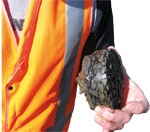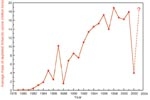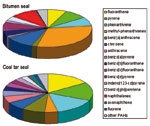PDF of this article (262 KB)





Coring a sample from a Christchurch road. Back in the lab, the different layers of seal are clearly visible in a section of the core. (Photos: Michael Ahrens)

Why are some urban streams more highly contaminated than others? Michael Ahrens, Craig Depree, and Greg Olsen have drilled to the core of the problem.
By global standards, most of our country’s streams are still relatively unpolluted. However, near centres of human activity, stormwater runoff and other inputs have lead to elevated levels of metals and organic contaminants. In order to reduce these inputs, environmental scientists and resource managers want to know where contaminants come from and how they get into our waterways. Environmental forensics is the process of collecting evidence to relate environmental problems to their likely causes.
PAHs – ubiquitous, toxic, and persistent
One prominent group of organic contaminants found in urban environments worldwide are the polycyclic aromatic hydrocarbons (PAHs), a class of ring-shaped compounds produced during the incomplete burning of fossil fuel or other types of organic matter. Most PAHs are thought to originate from motor vehicle emissions, domestic heating, or power plants, although forest fires and unprocessed fossil fuels, such as coal and oil, can be important sources as well. PAHs readily attach to sediment particles, leading to elevated concentrations in sediments.
Due to their hexagonal ring-structure, PAHs are very stable compounds that can persist in the environment for many years. This wouldn’t be much of a concern, were it not for an inconvenient fact: many PAHs are toxic. Furthermore, some PAHs can cause cancer (for example, the 5–ring PAH benzo(a)pyrene is one of the known carcinogens in cigarette smoke). As a rule, the greater the number of rings, the less water-soluble, more stable, and more toxic the PAH is. Eventually, PAHs in the environment are broken down by the action of bacteria, oxygen, and sunlight to form carbon dioxide and water.
The PAH source mystery
For many years, aquatic chemists monitoring urban contaminants in New Zealand noted exceptionally high sediment PAH levels in a number of inner city streams in Christchurch and Auckland – more than 100 times the typical mean. Such large differences could hardly be attributed to variations in traffic volume. To further the puzzle, the highest PAH concentrations in the stream sediments were not found downstream of the most heavily trafficked roads, but rather in streams in quiet, long-established residential neighbourhoods, on the coarsest grains, rather than on the fine grains characteristic of combustion soot. These observations suggested a mysterious, previously overlooked PAH source.Environmental forensics – getting to the core
To expose the elusive source of the high PAH levels in city streams, we analysed the PAH compositional pattern (or ‘fingerprint’) of stream sediments. PAHs commonly occur in the environment as a mixture of 15–30 different compounds, which vary in their relative abundance. By comparing the PAH fingerprint of a sediment sample with a variety of potential source materials, we hoped to identify likely suspects and eliminate unlikely ones. We collected sediments from several streams in Auckland and Christchurch and also obtained samples of possible source materials: petrol and diesel fuel, car tyres, motor oil, soot from vehicle tailpipes, chimney soot (from domestic and municipal furnaces), as well as road pavements. We extracted the PAHs from the different materials and carefully determined the abundance of the individual compounds, using a sensitive analytical instrument called a gas chromatograph mass spectrometer.
From fingerprint to exposé
The source material that most closely resembled the PAH composition of sediments in contaminated streams in Christchurch and Auckland turned out to be ... coal tar. This came as a big surprise since virtually no coal tar has been produced in New Zealand since the 1980s. However, during the last century coal tar was produced in large quantities as a by-product of coal gasification, a process by which coal is converted to coke and town gas (for cooking and heating) in a very hot furnace under oxygen-starved conditions. Coal tar as the sticky residue at the end of the gasification process. Coal tar has extremely high PAH content – up to 75% by weight. With over 50 gasworks operating in every major New Zealand town between the 1880s and 1980s, millions of litres of coal tar were produced.
What happened to all this coal tar? As it turns out, most of it ended up on our roads – as tar seal. Mixed with gravel, coal-tar produced an excellent, rugged, water-resistant paving material, well-suited for our rapidly growing fleet of motor vehicles. Best of all, coal tar was cheap and easy to come by. The downside: the high PAH levels. As a consequence of coal tar’s widespread use in road-building, substantial amounts of PAHs would have washed into roadside streams as stormwater runoff. This is confirmed by deep sediment cores from Auckland Harbour that show PAH levels were higher in past decades than they are now. With the rise of oil as the dominant fuel source (the Marsden oil refinery in Whangarei opened in 1964), coal tar was replaced by petroleum-based bitumen binders (also called asphalt) as the road seal of preference. This was a welcome change, not only for the environment, but also for road workers, since it was realised early on that coal tar had the potential to cause severe rashes and even skin cancers.
The legacy of tar seal
If coal tar is no longer used in road building, why is it still showing up in streams? To understand this, it helps to know that roads are typically re-sealed several times over the course of their lifetime before being rebuilt from their base. Thus, while all current roads in New Zealand are paved with asphalt, roads constructed before the 1960s may still contain coal tar in their base layers, especially in areas with low traffic volume.
To confirm this, we cored several roads and footpaths in pre–1960 residential neighbourhoods in Christchurch and Auckland and analysed the PAH composition in different pavement layers. Coal tar has roughly 4000 times higher PAH levels than bitumen and the PAH fingerprints of the two types of binders are very different. The road-coring study confirmed very high PAH levels in the deeper, older pavement layers, with a composition unmistakably resembling coal tar. Even more tellingly, the PAH composition of coal tar pavements closely matched that of adjacent stream sediments. In contrast, modern bitumen pavements had relatively low PAH levels, with a different PAH fingerprint, as did most of the other potential PAH sources analysed.This answered the question of the source of very high PAH levels in some urban streams. However, if older, deeper coal tar road layers are capped by bitumen, how does the coal tar get into the streams? The answer: probably very slowly – by gradual erosion of pavements and roadside soils that have accumulated coal tar fragments over years of wear and tear. This is confirmed by analyses of roadside soils and gutter debris from ‘coal-tarera’ Christchurch roads: these also showed exceptionally high levels and had the same conspicuous PAH fingerprint as coal tar and adjacent stream sediments. Because PAH levels in coal-tar binder are so high, it only takes a few tar speckles to elevate sediment PAH concentrations beyond normal urban levels. Even though use of coal tar for road-building ceased many years ago, we see its legacy decades later.
The solution: leave it, lock it in, or remove it?
Having solved the PAH source mystery, we are faced with the question: what to do about the high PAH levels in urban streams? This is the focus of ongoing research looking at toxicity and treatment options. If it can be shown that current sediment PAH levels are causing adverse effects in stream life, it will be necessary to find solutions to reducing PAH inputs. Based on what we have learned, the most effective starting place would be to minimise inputs of coal tar. This could mean rebuilding or re-sealing older roads that have a coal tar base. Alternatively, removing and capping PAH-rich roadside soils with clean soil might prove effective. While these remedies would not remove PAHs already present in stream sediments, over time clean sediments from the land would gradually dilute the high-PAH stream sediments.
Sleuthing out suspect stream sediments
- PAHs are widespread urban contaminants, commonly produced by burning fossil fuels.
- Sediments in some urban streams have a PAH ‘fingerprint’ that suggests an overlooked, historic source of pollution.
- Environmental forensics can help resource managers identify unknown sources of contamination.
Dr Michael Ahrens, Dr Craig Depree, and Greg Olsen are organic chemists working at NIWA in Hamilton. This study is part of the FRST-funded ‘Restoring Aquatic Ecosystems’ programme.
Teachers’ resource for NCEA Achievement Standards or Unit Standards: Chemistry Level 3 US6340 Geography Level 1 AS90207, Level 2 AS90336 Science Level 2 US6352, AS90771, Level 3 US6355, US8153 See other curriculum connections at www.niwa.co.nz/pubs/wa/resources
